Pool Maintenance
Is Your Pool Leaking? How to Tell and What to Do
Baffled by a potential pool leak? Learn how to spot the signs and take action before it's too late.

If you suspect your pool is leaking, watch for wet spots, unusual water movements, or cracks in the pool structure. Notice increased chemical demand, like frequent chlorine additions. Look for algae growth and stagnant water. Monitor your yard for ground settlement or excessive algae. Inspect the equipment area for spraying water, inspect pool shell and plumbing. Test with a bucket or dye test to confirm leaks. Swift action can prevent water loss and pricey repairs. Stay vigilant for early detection to maintain a healthy pool. Further info on leak detection methods and repair solutions awaits.
Key Takeaways
- Look for wet spots around the pool area as signs of leaks.
- Conduct a bucket test to detect significant water level drops.
- Inspect equipment area for ground moisture indicating hidden leaks.
- Hire professionals for accurate leak detection services.
- Address leaks promptly to prevent water loss and costly repairs.
Signs of Pool Water Loss
If you suspect your pool is leaking, there are several signs to watch out for to confirm your suspicions. Keep an eye out for wet spots in the yard, especially around the pool area. Standing water where it shouldn't be is a critical flag for potential leaks. Water near the pool that isn't from splashing or evaporation could indicate a leak.
Additionally, observe any unusual water movement, as this could suggest a problem with the pool's structure. Check the ground and walls for signs of a leak, such as cracks or shifting tiles.
To detect a leak, you can also use dye specifically designed for pool leak detection. Drop the dye into the water near where you suspect the leak might be and observe if it gets pulled towards a certain area, indicating a leak.
If you notice any of these signs, it's essential to take action promptly to repair the pool and prevent further water loss.
Increased Chemical Demand
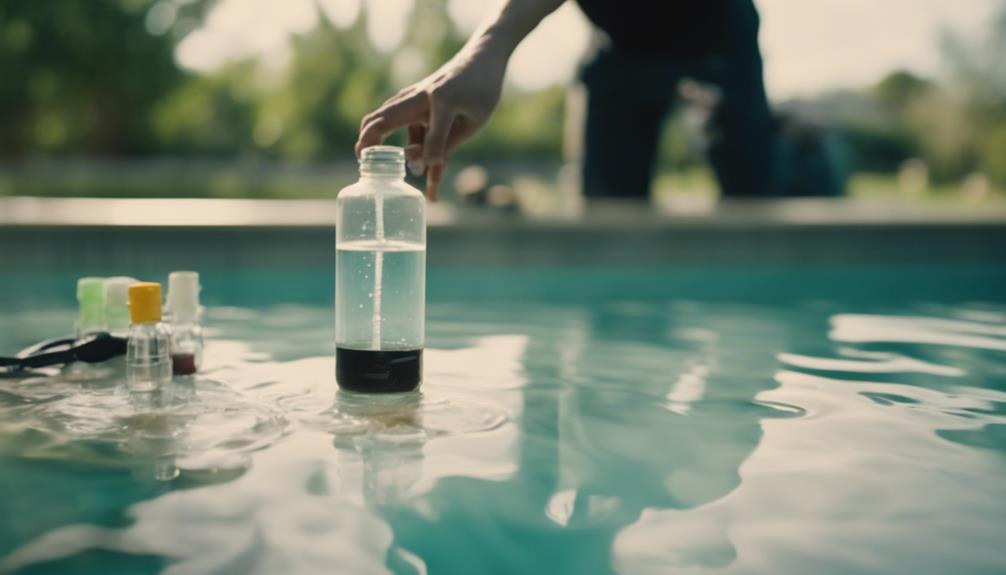
An indication that your pool might be leaking is an increase in chemical demand, which can disrupt the water balance and lead to frequent additions of chlorine to maintain proper levels.
When there's a leak in your pool, contaminants can seep in, causing a dilution of the water and making it harder to maintain water quality. This influx of impurities can throw off the chemistry of the pool, resulting in the rapid depletion of chemicals like chlorine.
If you notice unexplained fluctuations in your chemical readings despite your regular maintenance efforts, it could be a sign that a leak is causing the imbalance. Continuous adjustments in chemical dosages without improvement may also signal a leak compromising the effectiveness of your treatments.
It's essential to address pool leaks promptly to avoid ongoing chemical imbalances and the challenges associated with maintaining water quality. Regularly monitoring your pool's chemical levels can help you detect leaks early and prevent further issues with water balance.
Structural Pool Issues

If you notice cracks in your pool shell, falling tiles, or gaps in the bond beam, these could be signs of structural pool issues.
Untreated leaks can lead to ground settlement around your pool, potentially causing further damage to its foundation.
Keep an eye out for uneven ground, landscaping erosion, or excessive algae growth, as these could also indicate underlying structural problems that need immediate attention.
Cracks and Leaks
Dealing with cracks in your pool's structure can lead to leaks and potential water loss, posing challenges for maintenance and increasing the risk of damage. Pool leaks resulting from structural damage such as cracks not only affect your water bill but also create an environment conducive to algae growth and bacterial contamination. It is important to address these issues promptly to prevent further damage and costly repairs. Seeking professional assistance is recommended for accurately diagnosing and repairing structural pool leaks. Take into account the following factors when dealing with cracks and leaks in your pool:
| Factors to Take into Account | |
|---|---|
| Pool Leaks | Cracks in the pool structure can result in leaks, leading to water loss and potential damage. |
| Algae Growth | Structural damage can create an ideal environment for algae growth, necessitating timely repair. |
| Professional Assistance | Seeking help from professionals is essential for accurately diagnosing and repairing structural pool issues. |
Foundation Problems
Addressing foundation problems in your pool is essential for ensuring structural integrity and preventing potential leaks. When dealing with foundation issues in your pool, keep in mind the following:
- Cracks in the pool structure or falling tiles can indicate serious structural damage that needs immediate attention.
- Watch out for signs of unsettled ground around the pool and gaps in the bond beam, as these can lead to further problems with the pool structure.
- Ground settlement can result in landscaping erosion, uneven grass, and soft spots near the pool, indicating underlying foundation issues.
- Remember that structural damage from pool leaks can lead to costly repairs and impact the overall integrity of your pool. Seeking a professional assessment is vital to accurately diagnose and address any foundation problems to maintain the structural stability of your pool.
Algae Growth Concerns

If you spot green, slimy patches in your pool, it could signal a leak contributing to algae growth. Algae thrive in water with imbalanced chemicals, often caused by leaks, making it essential to address the issue promptly.
Keeping algae at bay involves proper identification, prevention methods, and effective treatment to maintain a clean and leak-free pool environment.
Algae Identification Tips
Detecting algae in your pool can provide valuable clues about potential water leakage issues. Here are some tips to help you identify algae growth:
- Appearance: Different types of algae may manifest as green, black, or yellow discoloration on pool surfaces, indicating a potential leak.
- Texture: Algae can create slippery or slimy areas in your pool, making it unsafe for swimming and signaling a disturbance in the chemical balance.
- Smell: A musty or unpleasant odor near the pool could be a sign of algae growth, which can worsen with warm temperatures and sunlight exposure.
- Water Clarity: Cloudy or murky water, often caused by algae proliferation, hints at a leak affecting the pool environment.
Preventing Algae Growth
To prevent algae growth in your pool, maintaining proper water circulation and chemical balance is vital. Algae growth can be a sign that your pool is leaking, as leaks disrupt the chemical balance and create a breeding ground for algae.
The stagnant water resulting from pool leaks provides an ideal environment for algae to thrive. Hence, prompt leak detection and repair are essential in preventing algae growth. Addressing leaks promptly not only maintains proper water circulation but also guarantees the chemical balance isn't compromised, reducing the risk of algae infestations.
By regularly monitoring and maintaining your pool's water chemistry and promptly addressing any leaks, you can effectively prevent algae growth. Remember, a well-circulated and chemically balanced pool not only looks inviting but also keeps algae at bay.
Stay proactive in leak detection and repair to enjoy a clean and algae-free swimming experience.
Treating Algae Infestations
Addressing algae infestations promptly is key to maintaining a clean and safe swimming environment in your pool. When it comes to treating algae growth, there are several essential steps to take into account:
- Prompt Leak Detection: Algae growth often signals a leak, emphasizing the importance of identifying and repairing leaks promptly to prevent further water imbalance.
- Balancing Water Chemistry: Maintaining proper water balance is vital for preventing algae outbreaks and ensuring a healthy pool environment.
- Thorough Cleaning of Pool Surfaces: Scrubbing and brushing pool surfaces regularly can help eliminate existing algae and prevent it from spreading.
- Preventing Equipment Damage: Algae can clog filters and damage pool equipment, underscoring the need for regular maintenance to keep your pool functioning properly.
Yard Wet Spots

If you notice wet spots in your yard near the pool, it is essential to be vigilant as it could be a sign of a potential leak in the plumbing or pool structure. These wet areas might not only indicate a leak in your pool but can also lead to water loss, landscaping issues, erosion, and even structural damage over time. Regularly checking for wet spots around your pool is vital to detect leaks early and prevent further damage. Addressing these wet areas promptly can help minimize water loss, avoid costly repairs, and maintain a healthy pool environment. To assist you in understanding the implications of yard wet spots, here is a table outlining the possible consequences and actions you can take:
| Issue | Potential Impact | Recommended Action |
|---|---|---|
| Plumbing Leak | Increased water loss and structural damage | Contact a pool maintenance expert |
| Pool Structure | Risk of further damage and compromised safety | Schedule an inspection |
| Landscaping | Erosion, damage to plants, and aesthetic issues | Re-evaluate landscaping design |
| Water Loss | Higher utility bills and environmental impact | Monitor water levels regularly |
| Structural Damage | Safety hazards and expensive repairs | Seek professional assistance |
Rising Water Bills
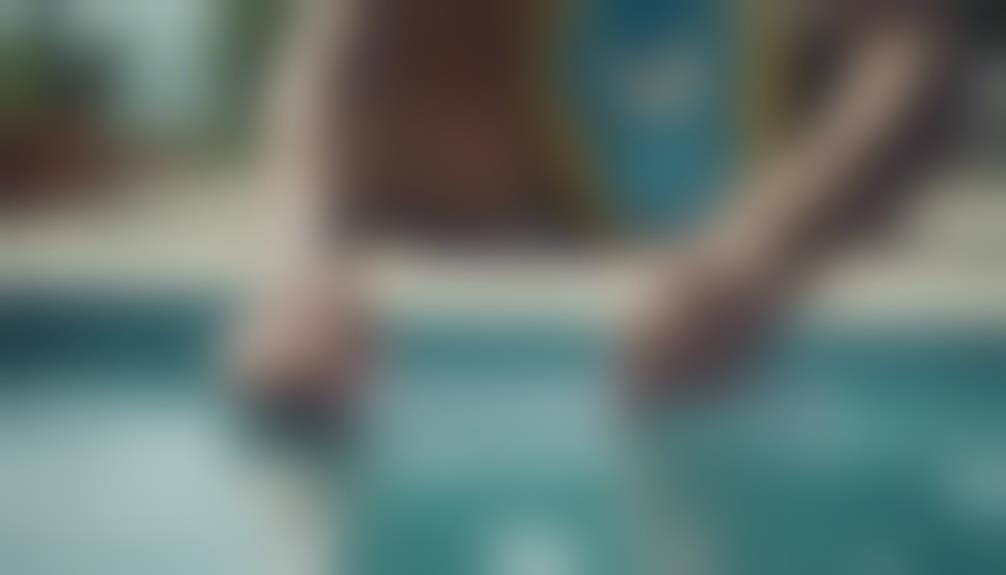
If you notice a sudden surge in your water bill, it could be a sign of a pool leak causing high water consumption.
Keep a close watch for unexplained water loss reflected in your bills, as undetected leaks can lead to increased expenses over time.
Investigating rising water bills promptly can help you pinpoint and address potential pool leaks before they become a financial burden.
High Water Consumption
Monitoring your water bills for unexplained increases can signal a potential pool leak that needs immediate attention. High water consumption leading to rising water bills could be indicative of a pool leak. Consider the following to understand the impact of abnormal spikes in water usage related to pool leaks:
- Financial Strain: Rising water bills due to pool leaks can strain your finances, increasing overall utility costs.
- Environmental Impact: Continuous water loss from pool leaks contributes to water wastage, impacting the environment.
- Property Damage: Pool leaks can cause structural issues, leading to costly repairs if left unaddressed.
- Preventive Action: Promptly investigating and fixing pool leaks can prevent further damage, reduce water wastage, and lower utility costs over time.
Be vigilant for wet spots or signs of structural issues around your pool area, as they may indicate a leak. Addressing pool leaks promptly not only saves you money but also helps conserve water and maintain your property's integrity.
Unexplained Water Loss
To detect a potential pool leak causing rising water bills, be attentive to unexplained water loss in your pool. If you notice that your pool is losing water at a faster rate than usual or without any apparent reason, it could be a sign of a potential pool leak.
Monitoring your water levels and tracking water usage can help you detect unexplained water loss. Rising water bills, especially when there hasn't been an increase in water usage, may indicate a pool leak that needs addressing promptly.
Ignoring unexplained water loss can lead to further damage and potentially costly repairs down the line. In such cases, it's advisable to contact professional pool leak detection services. These experts can accurately identify and repair any leaks that are causing the rising water bills, ultimately saving you from unnecessary expenses and preserving the integrity of your pool.
Equipment Area Water

Inspect the equipment pad for leaks by checking the filter, pump, heater, and valves for any signs of spraying water. Ground moisture around the equipment area could suggest hidden leaks that might be causing water loss in your pool. Significant water loss from your pool might indicate a major leak stemming from the equipment area.
Even small drips at the equipment pad shouldn't be overlooked, as they've the potential to develop into larger issues over time. Be attentive to any visible leaks or signs of water loss near your pool equipment to prevent further damage and maintain the integrity of your pool system.
Addressing leaks promptly can save you money on potential repairs in the long run.
Ignoring small leaks may lead to more significant issues with your pool equipment.
Regularly inspecting the equipment area can help you catch leaks early and prevent water loss.
Taking proactive measures to fix leaks promptly will help keep your pool in good condition.
Testing for Pool Leak

Check for pool leaks by conducting a bucket test to compare water levels and using a dye test near potential leak areas to detect any signs of water loss.
To perform a bucket test, fill a bucket with pool water and mark the water level inside it. Place the bucket at the pool's edge, ensuring it's immersed in water. After 24 hours, compare the water levels inside the bucket and the pool. If the pool water level drops more than the bucket, it may indicate a leak.
Additionally, conduct a dye test by adding dye near suspected leak areas; if the dye gets pulled into a crack or hole, there might be a leak present.
Remember to monitor water levels regularly, looking for any significant drops that could signify a leak.
For more accurate results, consider hiring professional pool leak detection services that may utilize pressure testing to detect underground leaks effectively.
Identifying Leak Source

Identify the source of the pool leak by conducting a thorough examination of the pool shell, plumbing system, equipment pad, and skimmers.
To pinpoint the exact location of the leak, consider using a dye test to visualize where the water is escaping.
Look for wet areas around the pool that could indicate a potential leak source. Additionally, stabilizing water levels can help narrow down the location of the leak.
Utilize a pressure test on underground plumbing to detect hidden leaks that may be affecting your pool.
Remember, professional pool service providers have specialized techniques and equipment to accurately identify the source of the leak.
If you suspect a leak near the pool pump or in the plumbing system, don't delay in addressing it to prevent further damage and costly repairs.
Professional Pool Service
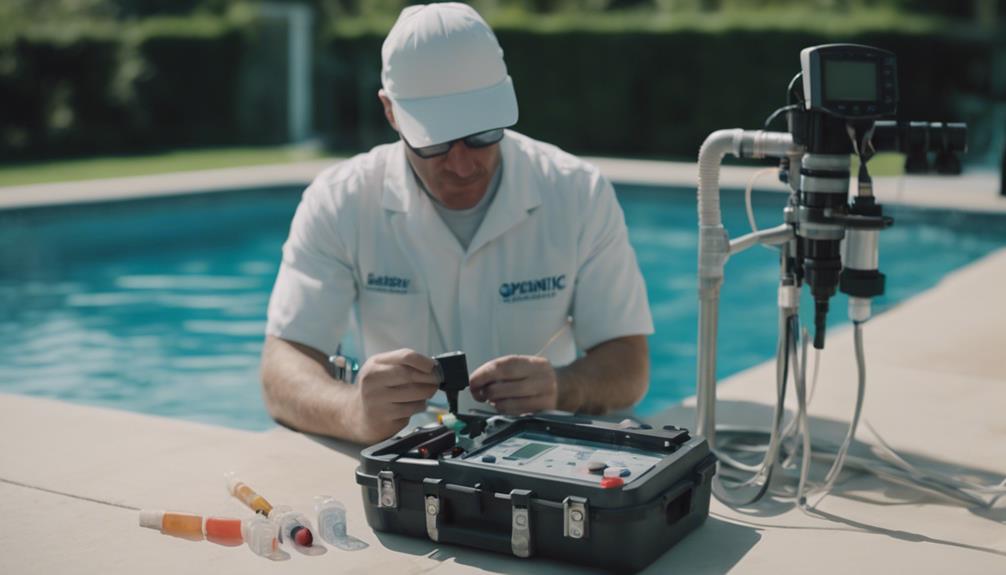
Consider enlisting the expertise of professional pool services for accurate leak detection and specialized repair solutions. When faced with a potential leak in your pool, these experts can employ advanced leak detection techniques to pinpoint the source of the issue.
By seeking expert assistance, you can guarantee that any necessary repairs are carried out effectively, preventing further damage. Professional pool technicians possess the knowledge and skills to diagnose and repair pool leaks efficiently, offering long-lasting fixes and preventive measures to maintain your pool's integrity over time.
Their specialized repair solutions are tailored to address the specific needs of your pool, ensuring that the problem is resolved correctly. Investing in professional pool services not only saves you time and hassle but also helps to safeguard the condition of your pool for the future.
Trusting the expertise of these professionals can provide you with peace of mind knowing that your pool is in good hands.
Frequently Asked Questions
How to Tell if a Pool Main Drain Is Leaking?
To determine if a pool main drain is leaking, observe excessive water loss from the drain or any wet spots near it.
Monitor the water level around the main drain for irregularities.
Perform a dye test around the drain to locate the leak accurately.
If you suspect a leak, contact a professional pool service for precise detection and repair.
Proper maintenance and early detection can prevent further damage to your pool.
Can You Fix a Pool Leak Without Draining?
You can indeed fix a pool leak without draining it. Utilize underwater repair materials like waterproof tape, peel-and-stick patches, or vinyl patch kits.
Choosing the appropriate method based on the leak's size and location is essential. Professional repair guides offer step-by-step instructions for efficient leak repairs without draining the pool.
Specialized techniques and materials designed for underwater repairs can address pool leaks effectively without the need to drain the pool.
How Do I Know if My Pool Return Line Is Leaking?
To determine if your pool return line is leaking, watch for air bubbles in the return line or water pooling around it. Monitor the water level closely, especially when the pump is running.
Conduct a dye test by adding dye near the return line to detect any leaks. If unsure, consider hiring a professional for a pressure test.
Regular inspection and timely repairs can help prevent extensive damage caused by leaks in the pool return line.
Can a Pool Lose Water Without a Leak?
Yes, a pool can lose water without a leak. Factors like evaporation, splashing, and backwashing contribute to water loss.
Evaporation, influenced by temperature and humidity, can cause significant water loss, up to 1/4 inch per day or 2 inches per week.
Regular monitoring and conducting a bucket test help differentiate between normal water loss and leaks.
If water loss exceeds typical evaporation rates, it may indicate a leak requiring professional inspection and repair.
Conclusion
To sum up, if you suspect your pool is leaking, it's crucial to carefully monitor for signs of water loss and take action promptly.
By identifying the source of the leak and seeking professional pool service, you can address the issue effectively and prevent further damage.
Remember, early detection is key to maintaining the integrity of your pool and enjoying a worry-free swimming experience.
Don't delay in addressing a potential leak to guarantee the longevity of your pool.
Pool Maintenance
Clear Water: How to Use Flocculant in Your Swimming Pool
Leverage the power of flocculant for your pool to achieve sparkling clarity – find out how in this comprehensive guide.

To use flocculant effectively for your swimming pool, start by determining the correct dosage based on your pool size and volume. Maintain a pH level between 7.4 and 7.6 for best results. Add the flocculant while the filter is set to 'Recirculate' and follow manufacturer instructions carefully. Allow the flocculant to settle overnight, then vacuum the settled particles using the 'Waste' setting on the filter. Make sure proper circulation for at least 2 hours post-flocculation. By mastering these steps, you'll achieve crystal clear water in your pool.
Key Takeaways
- Determine correct flocculant dosage based on pool size and water volume.
- Maintain pH between 7.4-7.6 and add flocculant on 'Recirculate' filter setting.
- Allow flocculant to settle for 8-24 hours before vacuuming on 'Waste' setting.
- Regular use of flocculant per manufacturer's instructions ensures crystal clear water.
- Vacuum slowly post-settling to remove particles and maintain pool water balance.
Benefits of Using Flocculant
Why should you consider using flocculant in your swimming pool?
Flocculant is a powerful tool in maintaining crystal clear pool water. By adding flocculant to your pool, you allow it to work its magic by causing small particles in the water to clump together. These clumps of particles become heavy enough to sink to the bottom of the pool, resulting in improved water clarity.
Not only does this process clear out cloudy pool water quickly, but it also reduces the need for frequent filter cleaning. This means less time spent on pool maintenance and more time enjoying your pool.
Additionally, using flocculant is a cost-effective solution that can save you money in the long run. So, if you want to enhance the clarity of your pool water, simplify your pool maintenance routine, and save on filter cleaning, incorporating flocculant into your pool care regimen is a smart choice.
Determining the Correct Dosage
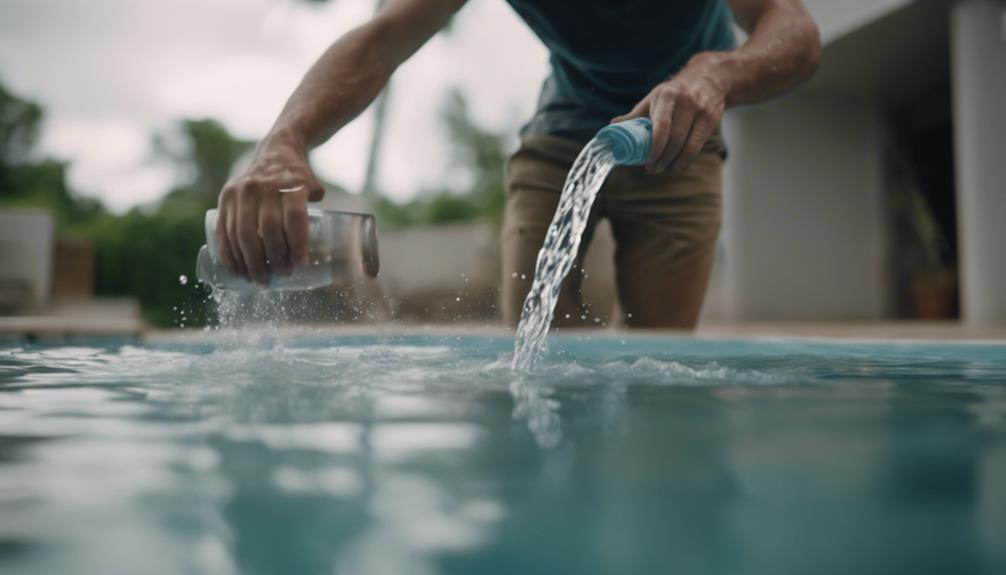
To guarantee proper use of flocculant in your swimming pool, ascertain the correct dosage based on factors such as pool size and water volume.
The best results for clear water depend on using the right amount of pool flocculant. Manufacturer instructions offer specific guidelines on the appropriate dosage tailored to your pool's needs.
Overuse of the flocculant can lead to water quality issues, while underuse may result in ineffective cleaning. It's essential to conduct research and understand the proper dosage for your specific pool to ensure clear and clean water.
Adding Flocculant to Pool Water
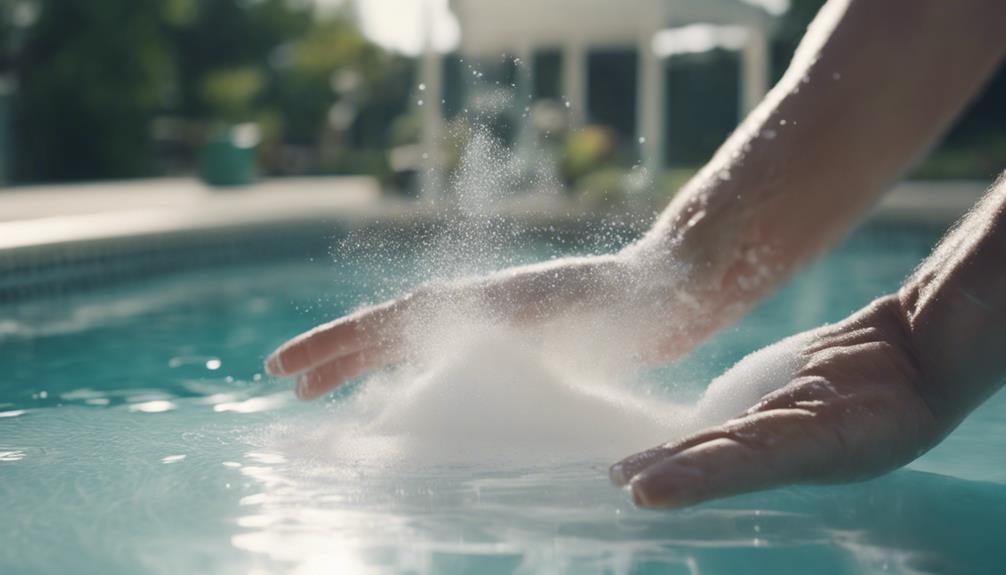
When adding flocculant to your pool water, it's essential to maintain a balanced pH level between 7.4 and 7.6 to guarantee peak effectiveness.
Remember to add the flocculant while the pool filter is set to 'Recirculate' to prevent clogging issues.
Additionally, the correct amount of flocculant should be added based on your pool's volume to achieve the desired results effectively.
Benefits of Flocculant
Using flocculant in your swimming pool enhances water clarity and cleanliness by effectively binding together tiny particles for easy removal. By adding flocculant to your pool water, you can experience a range of benefits:
- Improved Filtration: Flocculant works by clumping together small particles, allowing your pool filter to trap them more efficiently, resulting in cleaner water.
- Quicker Water Clarification: Cloudy or murky water can be quickly cleared up with the use of flocculant, saving you time and effort in maintaining your pool.
- Enhanced Removal of Impurities: Flocculant is effective in capturing algae, dirt, and other impurities that may not be caught by regular pool filters, ensuring a thorough cleaning process.
These benefits not only contribute to better water clarity but also enhance overall pool hygiene, providing you with a more enjoyable and invigorating swimming experience.
Flocculant is a convenient and efficient solution for achieving crystal clear pool water in a short amount of time.
Application Process Explained
Enhance the clarity and cleanliness of your swimming pool by following the simple application process for adding flocculant to your pool water. Start by adding the recommended amount of flocculant according to the manufacturer's instructions. Turn your pool filter to the 'Recirculate' setting to allow the flocculant to circulate for a minimum of 2 hours, effectively clumping particles together. Once the circulation period is complete, switch the filter setting to 'Waste' and manually vacuum the settled particles from the pool. If necessary, repeat the process until your pool water achieves crystal clear clarity.
| Application Process Steps | Details |
|---|---|
| 1. Add Flocculant | Follow manufacturer's instructions |
| 2. Circulate | Set filter to 'Recirculate' for 2 hours |
| 3. Vacuum | Switch filter to 'Waste' and manually vacuum |
| 4. Repeat if needed | For crystal clear water |
Maintenance Tips After Flocculation
To maintain the clarity and cleanliness of your pool water after adding flocculant, guarantee proper circulation for at least 2 hours.
Once the circulation period is complete, turn off the pump and let the flocculant settle at the bottom of the pool overnight.
The following day, utilize the Waste setting on your filter to carefully vacuum the settled particles from the pool floor.
Remember to top up the pool water level post-vacuuming to maintain proper water balance.
Additionally, make sure you balance the water chemistry after using flocculant to uphold crystal clear and healthy pool water.
Proper maintenance post-flocculation is essential for the effectiveness of the treatment and the overall well-being of your pool.
Allowing Flocculant to Settle

When allowing flocculant to settle in your pool, remember that the timing of this process is vital to achieve clear water. Waiting for about 8 to 24 hours allows the flocculant to bind particles effectively.
During this time, the treated particles will gradually sink to the pool's bottom, preparing them for efficient removal.
Settling Process Timing
For best results, allow the flocculant to settle in your swimming pool for a recommended period of at least 8-12 hours. The settling process is vital for the particles to clump together and sink to the bottom of the pool, resulting in clearer water.
Here are some key points to keep in mind during the settling process:
- Time Matters: Settling time may vary based on the amount of flocculant used and the current pool conditions. It's advisable to follow the manufacturer's guidelines for the best results.
- Overnight Settling: Allowing the flocculant to settle overnight is often recommended to ensure maximum effectiveness. Patience during this time is crucial to achieving crystal clear water.
- Avoid Disturbance: It's important not to disturb the settled particles while they're in the process of sinking to the bottom. Any disruption could impede the effectiveness of the flocculant, making it more challenging to achieve the desired outcome.
Clear Water Results
As the flocculant settles in your pool water, small particles begin to clump together for easier removal. It's essential to let the flocculant work overnight or for a minimum of 8 hours to achieve best results.
During this time, the settled particles will form a visible layer at the bottom of your pool, indicating the effectiveness of the flocculant. Patience is key in this process; the longer you allow the flocculant to work, the clearer your pool water will become.
Once the flocculant has settled the particles, you can proceed with manual vacuuming to effectively remove the debris from your pool. This combination of settling the particles with flocculant and manual vacuuming is vital for maintaining clear water in your pool.
Vacuuming the Pool
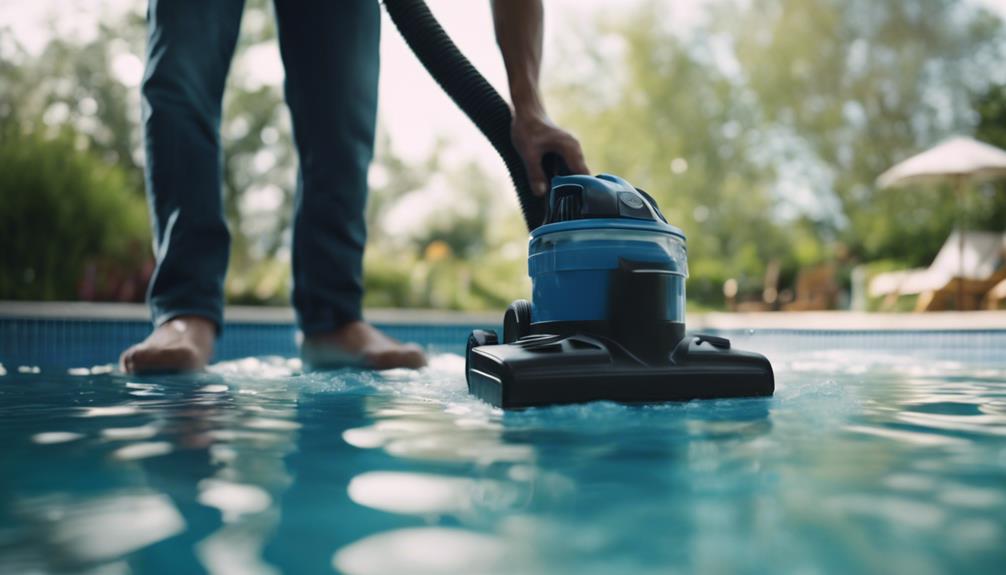
To effectively remove settled particles in your swimming pool after adding flocculant, vacuum the pool using slow and steady motions. This step is essential for pool maintenance to guarantee a clear and clean pool.
Here are some key tips to keep in mind:
- Use the 'Waste' Setting: When vacuuming after adding flocculant, make sure to use the 'Waste' setting on your filter. This setting allows you to vacuum out the waste water along with the particles, keeping your pool clean.
- Slow and Steady Vacuuming: Avoid stirring up settled debris by vacuuming slowly and steadily. This method helps to effectively remove settled particles without causing them to disperse back into the water.
- Top Up Pool Water: After vacuuming the pool, remember to top up the water to maintain proper levels. This simple step helps to ensure that your pool functions optimally and stays crystal clear.
Vacuuming the pool after using flocculant is a vital part of pool maintenance, contributing to a sparkling swimming experience.
Regular Use for Pristine Water

Consistently using flocculant in your swimming pool is key to maintaining pristine water quality. Adding this chemical once or twice a week plays a vital role in keeping your pool water clear and clean.
To guarantee best results, always follow the manufacturer's instructions for flocculant dosage.
By using flocculant regularly, you help in capturing small particles that may cloud the water, thereby maintaining crystal clear water in your pool.
Incorporating flocculant into your routine pool maintenance can effectively prevent issues like cloudy water and algae buildup.
Remember, the key to enjoying a sparkling pool lies in the regular use of flocculant as part of your maintenance regimen.
Stay proactive in caring for your pool, and you'll consistently enjoy the benefits of pristine, inviting water for all your swimming and leisure activities.
Frequently Asked Questions
How to Use Flocculant in a Swimming Pool?
To use flocculant in a swimming pool, follow these steps:
- Add the recommended amount based on your pool's volume.
- Let the pool pump run for at least 2 hours to distribute the flocculant evenly.
After 8 hours, vacuum the pool to remove settled particles at the bottom.
For better results, consider adding flocculant in the evening for overnight settling.
Don't forget to top up the pool water after vacuuming to maintain the proper water level.
How Much Liquid Flocculant Do I Put in My Pool?
You should consider the size of your pool and the manufacturer's guidelines when determining the amount of liquid flocculant to add.
A general rule of thumb is using around 8 ounces to 1 quart of liquid flocculant per 10,000 gallons of water.
Following the recommended dosage is essential to prevent issues like water clarity problems.
Over-treating or under-treating can lead to ineffective results, so make sure you measure accurately for best pool water clearing.
Can You Add Flocculant and Chlorine at the Same Time?
You shouldn't add flocculant and chlorine at the same time. It's generally recommended to add them separately due to potential chemical reactions.
Chlorine is essential for sanitizing the pool, while flocculant is used to clarify cloudy water. Adding them individually allows each chemical to effectively perform its specific function.
Start by adding chlorine first to sanitize the water, then follow with flocculant to clear particles, ensuring best results for your pool maintenance.
Will Floc Clear a Green Pool?
Yes, floc can effectively clear a green pool by clumping together algae particles for easier removal. It accelerates the process compared to traditional methods, making it an ideal solution for severe algae blooms causing green water.
Proper dosage and application of floc are essential for successful results. Remember to vacuum the settled particles post-treatment to achieve a clear and inviting swimming pool.
Conclusion
To sum up, using flocculant in your swimming pool can effectively clarify cloudy water by removing small particles and debris. By following the correct dosage, allowing the flocculant to settle, and then vacuuming the pool, you can maintain clear and pristine water for a more enjoyable swimming experience.
Regular use of flocculant will help keep your pool water crystal clear, ensuring a clean and inviting environment for you and your guests.
Pool Maintenance
Saltwater Pool Maintenance: How to Care for a Saltwater Swimming Pool
Optimize your saltwater pool maintenance routine with expert tips to ensure crystal-clear water and a refreshing swim every time.
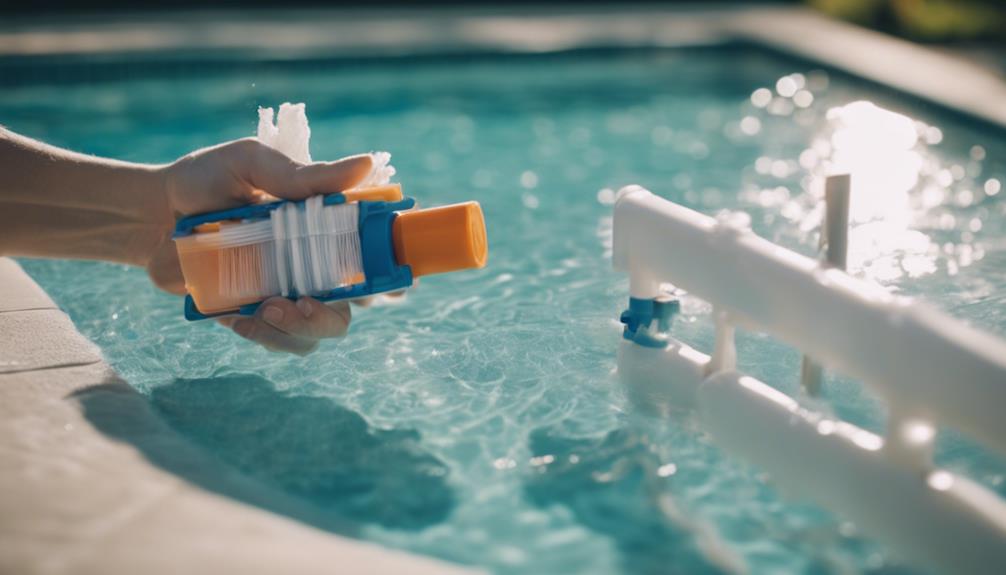
To care for a saltwater swimming pool, make sure you use 99% pure pool-grade salt and maintain salinity levels at 2,700-3,400 PPM. Run the pool pump for at least 8 hours daily for proper circulation, preventing debris buildup, algae growth, and ensuring even salt and chlorine distribution. Balance pH levels to prevent calcium buildup and regularly clean the salt cell to maintain chlorine production. Monitor pH (7.2-7.6) and free chlorine (1-3 ppm) levels for a safe swimming environment, shock the pool weekly, and perform regular cleaning and water quality testing to prevent issues. Following these steps guarantees the best pool maintenance.
Key Takeaways
- Use pool-grade salt with at least 99% purity to maintain salinity levels.
- Ensure proper water circulation by running the pump and filter for 8 hours daily.
- Prevent calcium buildup by maintaining pH levels and testing calcium hardness.
- Regularly clean the salt cell every 3 months to avoid water quality issues.
- Maintain balanced pH and chlorine levels through weekly testing and adjustments.
Proper Salt Addition
To properly maintain your saltwater pool, make sure you use pool-grade salt that's at least 99% pure when adding salt to the water. Maintaining the correct salt levels is essential for the best performance of your pool, with the recommended salinity level falling between 2,700 to 3,400 parts per million (PPM).
When adding salt, guarantee proper distribution by turning on the pool filter system to circulate the salt for 24 hours. This step is important to achieve thorough mixing and prevent localized high concentrations of salt.
To accurately monitor the salt levels, use a digital salinity tester to check various areas of the pool, ensuring uniformity. Regularly testing and adjusting salt levels around the pool is crucial to maintain water quality and prevent any potential issues that may arise from inconsistent salinity levels.
Maintaining Water Circulation
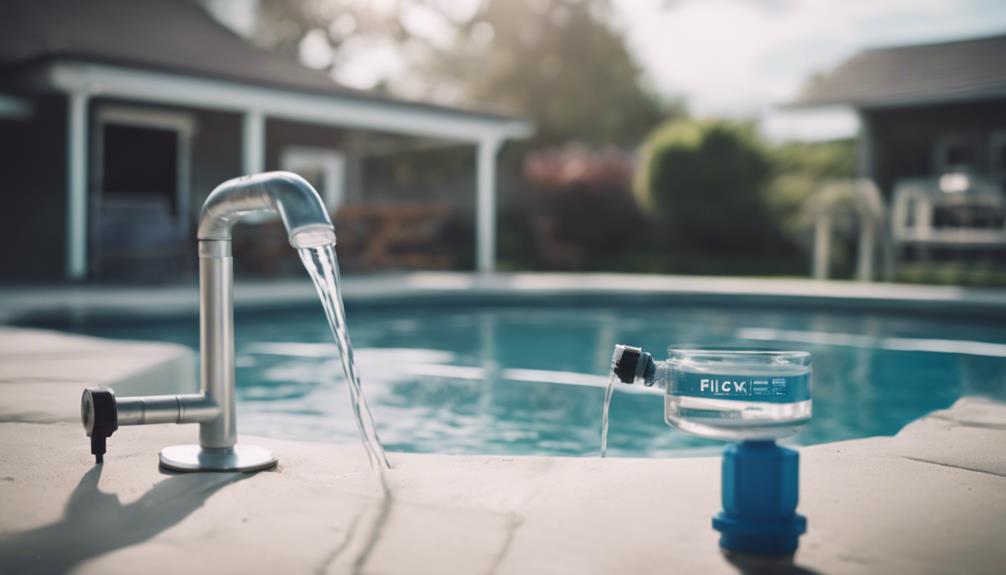
For peak water quality and pool cleanliness, make sure you run the pool pump and filter for a minimum of 8 hours daily to maintain proper circulation in your saltwater pool.
Adequate water circulation is vital for evenly distributing salt and chlorine throughout the pool, which is essential for effective sanitation. By ensuring proper water circulation, you can prevent the buildup of dirt and debris, thereby contributing to the overall cleanliness of your pool.
Additionally, consistent circulation helps maintain balanced water chemistry by evenly dispersing chemicals, creating a safe swimming environment for you and your family.
Stagnant areas in the pool are minimized through continuous water circulation, reducing the risk of algae growth and other water quality issues.
Preventing Calcium Buildup
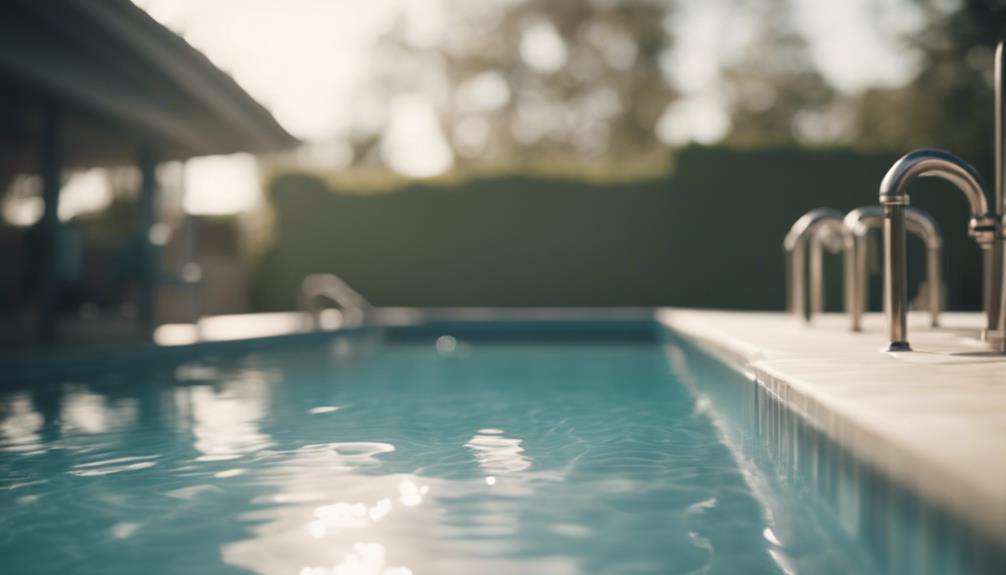
Maintain proper pH levels to prevent calcium buildup around your pool and avoid scaling and corrosion.
Calcium buildup occurs when the water becomes oversaturated with calcium, leading to the formation of scaling on pool surfaces. To prevent this, it's important to monitor and regulate the pH levels in your pool regularly.
Imbalanced pH levels can contribute to the precipitation of calcium, resulting in unsightly deposits that are challenging to remove. Additionally, maintaining proper water chemistry is vital in preventing calcium buildup.
By routinely testing and adjusting the calcium hardness levels in your pool, you can avoid excessive accumulation of calcium that can lead to scaling issues. Using a calcium remover or a mild acid solution can help dissolve existing calcium deposits and prevent new buildup.
Checking Salt Cell Cleanliness
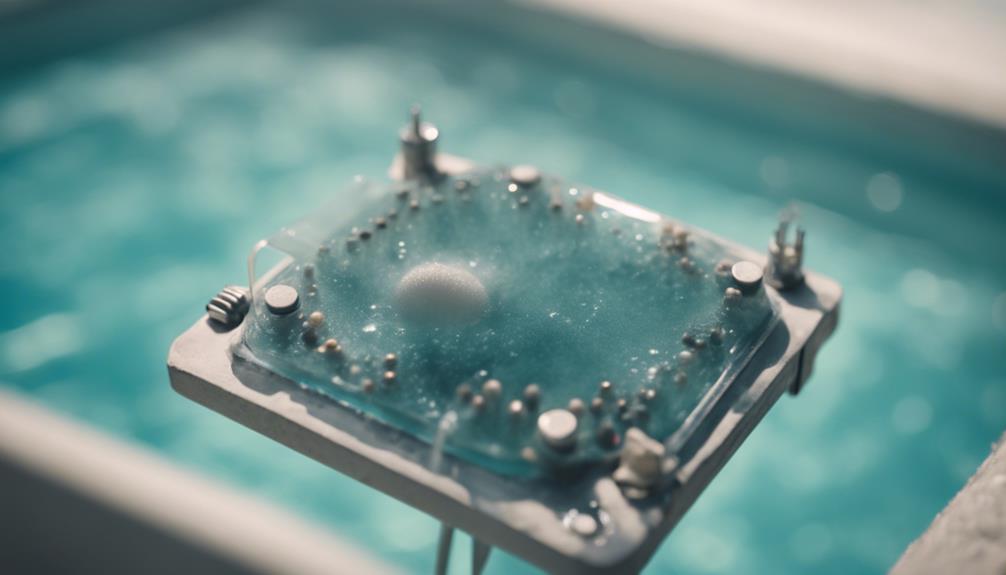
When it comes to maintaining your saltwater pool, checking the cleanliness of your salt cell is essential. Regularly inspecting the salt cell every 3 months can help prevent scale buildup and guarantee efficient chlorine generation.
Use a high-pressure hose or consider a mild acid wash to clean out any deposits that may hinder its performance.
Salt Cell Inspection
Regularly inspecting the salt cell every 3 months for calcium buildup or scale deposits is essential for maintaining the efficiency of your salt chlorinator system. When you inspect the salt cell, keep an eye out for any signs of white deposits or flakey spots on the surface. These can indicate the presence of calcium buildup or scale deposits, which can hinder the proper functioning of your salt chlorinator. By catching these issues early through regular inspections, you can guarantee that your salt cell continues to operate effectively.
Inspecting the salt cell is a simple yet important step in your pool maintenance routine. If you notice any buildup or deposits, you can then proceed to clean the salt cell using a high-pressure hose or a mild acid solution. Following the manufacturer's instructions for cleaning is crucial to prevent damage to the salt cell.
Cleaning Process
Check the cleanliness of your salt cell regularly to guarantee maximum chlorine production and prevent maintenance issues. Scale buildup on the salt cell can impede chlorine production, leading to water quality problems.
Inspect the salt cell every three months for any deposits or scaling. If you notice buildup, use a high-pressure hose or a mild acid solution to clean the cell thoroughly.
Proper maintenance of the salt cell is essential for efficient chlorine production and to extend the life of the cell. Neglecting to clean the salt cell can result in decreased chlorine levels, potentially causing algae growth or other water quality issues.
Following the manufacturer's guidelines for cleaning the salt cell is vital to ensure safe and effective maintenance. Remember to wear appropriate protective gear, such as gloves and goggles, when handling chemicals during the cleaning process.
Balancing Ph and Chlorine Levels

Maintaining the appropriate pH levels between 7.2-7.6 is essential to prevent skin and eye irritation in your saltwater pool.
Monitoring free chlorine levels at 1-3 ppm is vital for effective sanitation and algae prevention.
Properly balancing your pool's chemistry by adjusting chlorine and pH levels through regular testing ensures a safe and comfortable swimming environment for you and your guests.
Ph Level Importance
Properly balancing the pH and chlorine levels in your saltwater pool is essential for maintaining water clarity and sanitation. pH balance, ranging from 7.2 to 7.6, is vital for the effectiveness of free chlorine levels in your pool.
When pH levels are imbalanced, it can lead to poor chlorine performance, potentially causing algae growth and jeopardizing water quality. Regularly testing and adjusting pH levels is key to ensuring that your pool remains clean and safe for swimming.
High pH levels can reduce chlorine's effectiveness, requiring more chemicals and increasing maintenance costs. By monitoring and maintaining the correct pH levels in your saltwater pool, you not only promote efficient chlorine function but also guarantee a safe and enjoyable swimming experience for everyone.
Chlorine Level Monitoring
To maintain ideal sanitation and water quality in your saltwater pool, consistent monitoring of chlorine levels is essential for guaranteeing a safe and enjoyable swimming environment. Keeping the chlorine levels within the recommended range of 1-3 parts per million (ppm) is critical to effectively sanitize the pool water.
Additionally, balancing pH levels between 7.2-7.6 is essential to prevent skin and eye irritation and to ensure the effectiveness of chlorine in keeping your pool clean. Remember to adjust the chlorine output as needed based on regular test results to maintain a healthy swimming environment.
Properly balanced pH and chlorine levels are the key to a pleasant and safe swimming experience in your saltwater pool.
- Regularly test and monitor chlorine levels.
- Maintain chlorine levels between 1-3 ppm.
- Balance pH levels between 7.2-7.6.
- Adjust chlorine output based on test results.
- Ensure proper pH and chlorine levels for a healthy swimming experience.
Balancing Pool Chemistry
Regularly testing and adjusting pH and chlorine levels in your saltwater pool is essential for maintaining water balance and sanitation. pH levels should be tested weekly, aiming for a range of 7.2-7.6 to maintain proper water balance.
Monitoring and adjusting free chlorine levels between 1-3 ppm is important for effective sanitation. Utilize baking soda to raise pH levels and sodium carbonate or muriatic acid to lower them as needed.
Maintaining appropriate chlorine levels not only prevents algae growth but also ensures the safety of the water. Balancing pH and chlorine levels is crucial to prevent equipment corrosion and maintain high water quality standards.
Weekly Pool Shocking

To maintain your saltwater pool effectively, make sure to shock it weekly with a high dose of chlorine to eliminate bacteria, algae, and contaminants. This weekly shocking routine is essential for maintaining water clarity and sanitation in your saltwater pool.
Factors such as heavy pool use, high temperatures, and rainfall can increase the need for weekly shocking to keep the water clean and safe for swimming. When selecting a shock treatment, opt for a non-chlorine shock specifically designed for saltwater pools to prevent damage to the system.
Regular pool shocking not only kills bacteria and algae but also helps prevent common issues like cloudy water, algae growth, and unpleasant odors. By incorporating weekly shocking into your pool maintenance routine, you can ensure that your saltwater pool remains an invigorating and enjoyable oasis for you and your family to relax and swim in.
Skimming, Brushing, Vacuuming
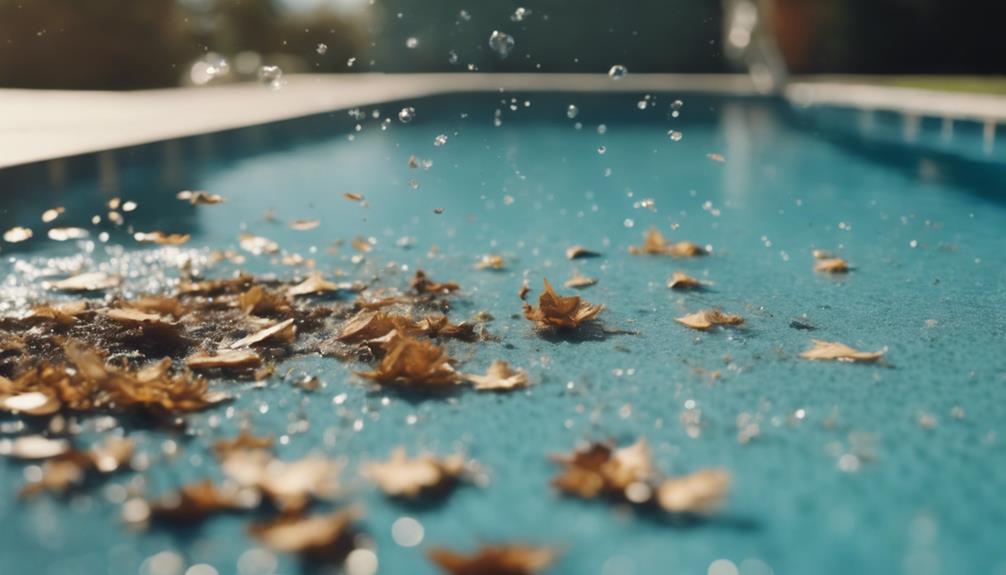
Maintaining a clean and clear saltwater pool involves daily skimming to remove debris and prevent buildup in the water. By skimming the pool surface regularly, you can prevent leaves, bugs, and other debris from sinking to the bottom and causing water quality issues.
Additionally, brushing the pool walls and floor on a weekly basis is important to prevent algae growth and maintain overall cleanliness. Algae can quickly spread in neglected areas, leading to cloudy and uninviting water.
Moreover, vacuuming the pool at least once a week is essential to remove dirt, leaves, and other debris that may have settled on the bottom. These routine maintenance tasks, including skimming, brushing, and vacuuming, play a significant role in keeping your saltwater pool crystal clear and reducing the need for excessive chemical treatments.
Regular Water Quality Testing
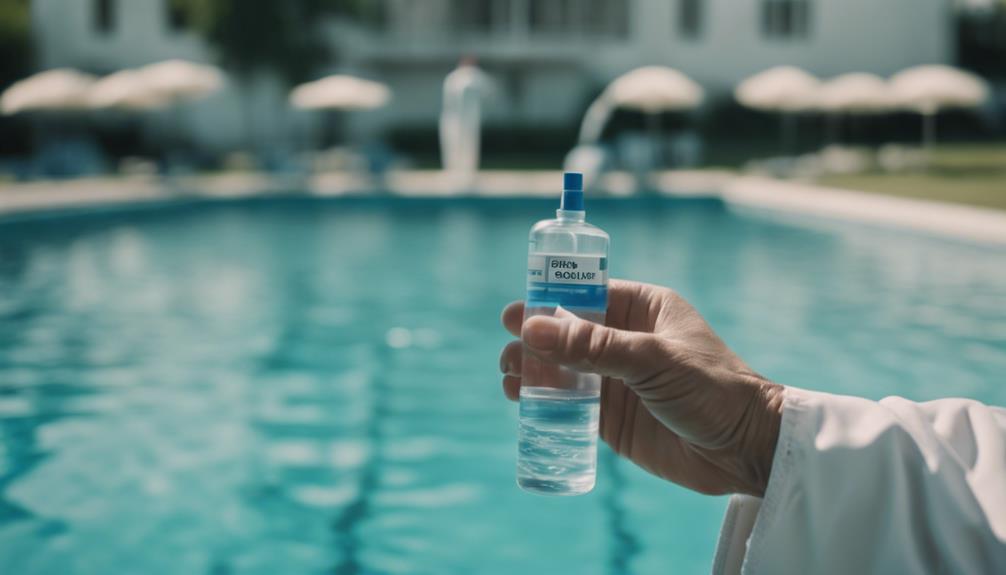
Guarantee proper sanitation and safety for swimmers by testing the free chlorine levels weekly in your saltwater pool.
Monitoring pH levels is also vital, especially considering the naturally high pH in saltwater systems. To maintain ideal water quality and prevent issues, it's vital to balance both pH and chlorine levels.
Additionally, testing alkalinity, stabilizer, and calcium levels monthly is key to ensuring a well-balanced pool environment. Aim to keep alkalinity levels between 100 and 150 parts per million (PPM) for the best pool water chemistry.
- Test chlorine levels weekly: Ensures safe swimming conditions.
- Monitor pH levels regularly: Prevents imbalances that can lead to skin and eye irritation.
- Balance pH and chlorine levels: Maintains water quality and prevents algae growth.
- Test alkalinity, stabilizer, and calcium levels monthly: Ensures a well-balanced pool chemistry.
- Maintain alkalinity between 100 and 150 PPM: Best for pool water chemistry.
Troubleshooting Common Issues
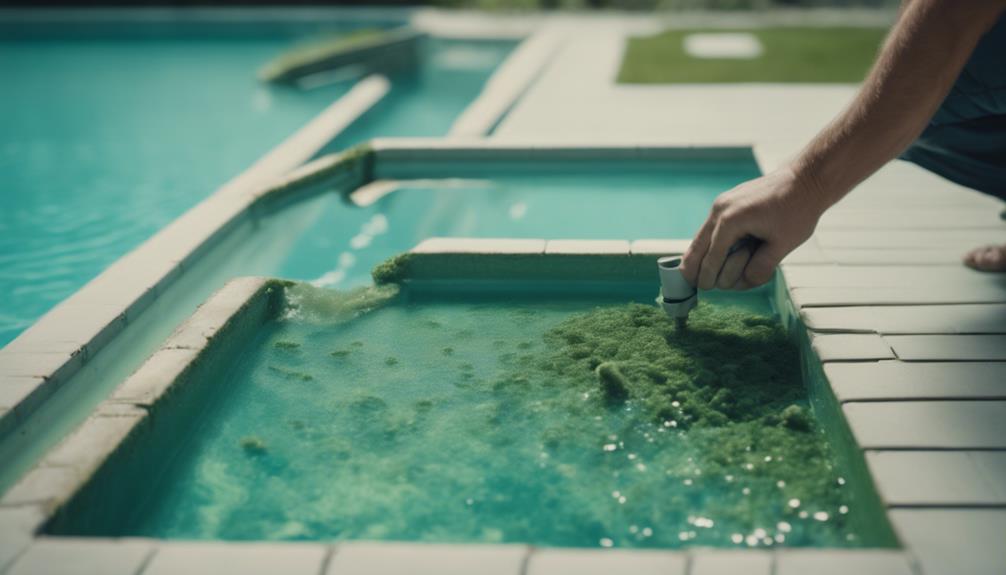
Troubleshoot common issues in your saltwater pool by identifying and addressing factors contributing to cloudy water, algae growth, and corrosion. Cloudy water often indicates a chlorine deficiency or a poorly functioning filtration system. To combat algae growth, ensure proper chlorine levels are maintained and run the pool pump regularly. Corrosion problems can arise from high salt levels, requiring diligent monitoring and dilution of concentrations. Regularly testing pH, alkalinity, and salt levels is crucial in troubleshooting and preventing common saltwater pool issues. By staying on top of maintenance tasks and testing water quality consistently, you can detect and address water quality problems early, ensuring a safe swimming environment for you and your family.
—
| Common Issue | Causes | Solutions |
|---|---|---|
| Cloudy Water | Chlorine deficiency, poor filtration | Test and adjust chlorine levels, check filtration system |
| Algae Growth | Insufficient chlorine, lack of regular pump operation | Maintain proper chlorine levels, run pump regularly |
| Corrosion Issues | High salt levels | Monitor, dilute salt concentrations as needed |
Converting to Saltwater Pool
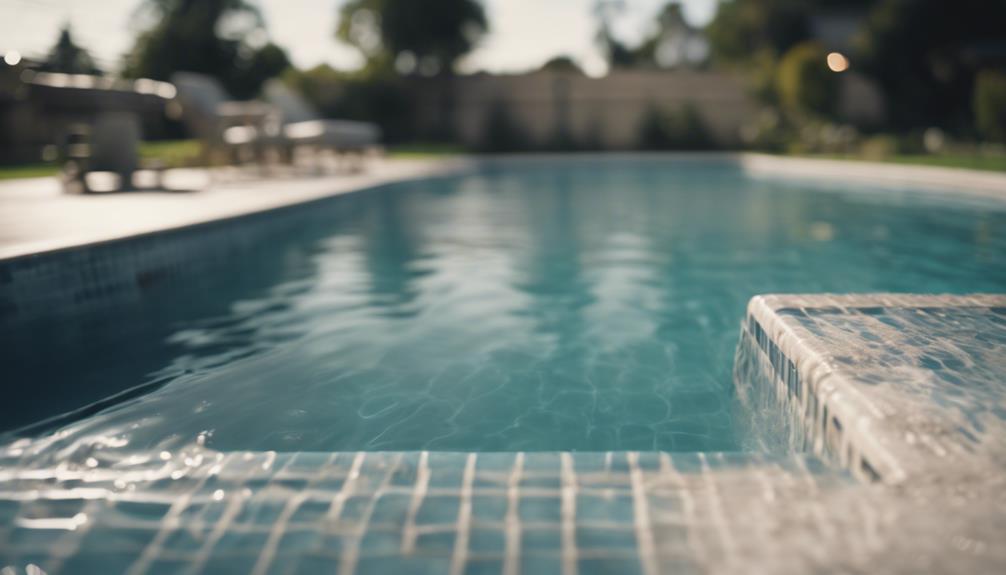
To successfully convert your traditional pool into a saltwater pool, start by purchasing a saltwater chlorinator system designed for your specific pool size and requirements.
Ensure a smooth changeover by following these steps:
- Drain and Clean: Prepare your pool by draining and cleaning it thoroughly before installing the saltwater system to guarantee peak performance.
- Add Salt: Follow manufacturer instructions and add the correct amount of pool-grade salt based on your pool's size to achieve the desired salinity.
- Test pH Levels: Regularly test and adjust pH levels after the conversion to maintain proper water balance and comfort for swimmers.
- Secure Connections: Before activating the saltwater system, verify that all connections are secure to prevent potential leaks or malfunctions that could impact the conversion process.
- Maintenance: Stay proactive with regular upkeep and monitoring to keep your saltwater pool in top-notch condition for long-term enjoyment.
Frequently Asked Questions
What Is Routine Maintenance for a Salt Water Pool?
Routine maintenance for a saltwater pool involves weekly tasks such as pH level testing and adjustment, and regular monitoring and adjustment of free chlorine levels for sanitation.
Maintaining the correct salinity level of 2,700 to 3,400 PPM is essential for pool health. Cleaning and inspecting the salt cell every 3 months ensures ideal chlorine generation.
Additionally, weekly tasks like skimming, brushing, and vacuuming help keep the water clear and free of debris.
Is It Difficult to Maintain a Saltwater Pool?
Maintaining a saltwater pool is generally easier than a traditional chlorinated pool due to the self-regulating nature of salt chlorination systems. The process requires less monitoring and adjustment of chlorine levels, reducing maintenance efforts.
While initial setup costs may be higher, long-term maintenance expenses are often lower. Regular testing of salt levels and water chemistry, along with cleaning the salt chlorinator cell, are key tasks for proper upkeep.
Soft, gentle water and reduced skin and eye irritation are benefits of well-maintained saltwater pools.
Do You Need to Add Chemicals to a Saltwater Pool?
Yes, you need to add chemicals to a saltwater pool.
Despite the misconception that saltwater pools are maintenance-free, you still require regular monitoring and adjustment of pH, alkalinity, stabilizer levels, and occasional additions of muriatic acid, shock treatment, or algaecides.
Testing for free chlorine and salt levels is vital for water quality.
While saltwater pools generate chlorine, supplemental chemicals are essential for balance and safe swimming conditions.
How Often Should I Add Salt to a Salt Water Pool?
You should add salt to your saltwater pool when levels fall below the recommended range of 2,700 to 3,400 parts per million (PPM).
Factors like heavy rain, splash out, or dilution from adding fresh water can lower salt levels. Use a digital salinity tester to measure salt levels accurately in various pool areas.
Adding salt after rain or water addition helps maintain ideal salinity for efficient chlorine generation. Remember to turn off the chlorine generator while adding salt for proper distribution and functionality.
Conclusion
In summary, maintaining a saltwater pool doesn't have to be a challenging task. By following the proper care and maintenance steps outlined in this article, you can guarantee your pool stays clean, safe, and enjoyable for all swimmers.
Remember, a little effort goes a long way in keeping your saltwater pool in top condition. So don't let misinformation deter you – with the right knowledge and approach, you can easily care for your saltwater swimming pool like a pro.
Pool Maintenance
Using Flocculant in Your Pool: A Guide
Master the art of achieving crystal-clear pool water with the transformative power of flocculant – your key to a visually stunning swimming experience.
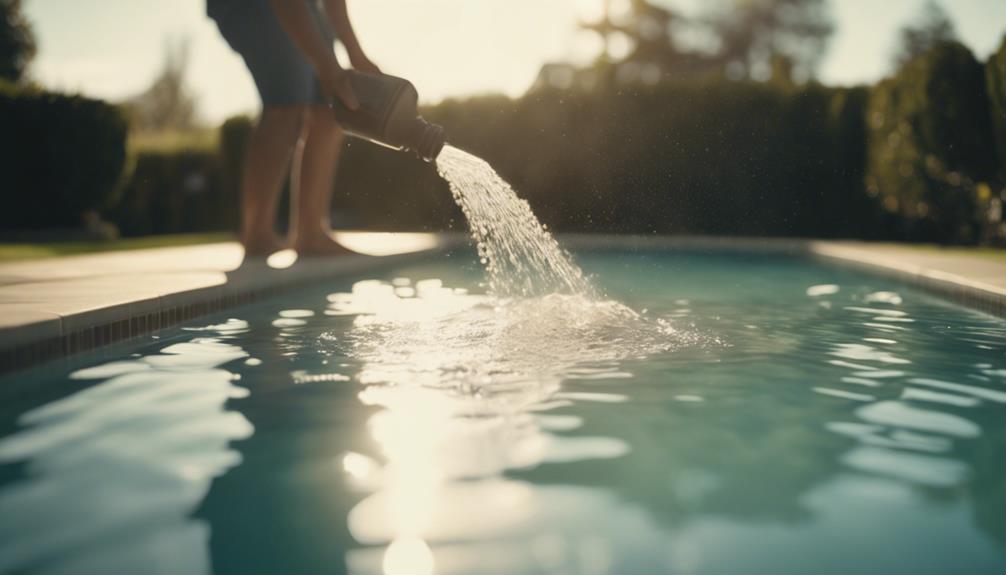
Using flocculant in your pool can significantly enhance water clarity and filtration efficiency. This aids in achieving a cleaner and visually pleasing swimming environment. Flocculant works by clumping particles together, allowing them to sink to the bottom for easier removal. To use it effectively, guarantee proper dosage, avoid disturbing settled particles, and run the pool pump for peak circulation. Address common issues like incomplete removal or balanced chemistry promptly. Following precise application tips and manufacturer instructions is crucial for maintaining a clear pool. Vacuuming thoroughly post-treatment is essential for crystal-clear water. Discover more benefits and details about using flocculant in your pool.
Key Takeaways
- Properly balance pH levels before applying flocculant.
- Allow flocculant to circulate for at least 2 hours.
- Vacuum pool thoroughly after particles settle.
- Follow manufacturer instructions precisely for best results.
- Dispose of excess flocculant properly to avoid environmental harm.
What Is Pool Flocculant?
Pool flocculant, whether inorganic or organic, plays an important role in maintaining the cleanliness and clarity of your pool water. When it comes to treating pool water, pool flocculant is essential for dealing with small particles that can make your pool water appear cloudy or murky.
Inorganic flocculants, such as aluminum sulfate, and organic flocculants, like polymers, are the two main types used for this purpose. Organic flocculants are generally more effective in water treatment compared to inorganic ones.
The function of pool flocculant is to create a floc blanket in the water, which binds with these small particles. This binding process causes the particles to clump together and eventually sink to the pool bottom. This process, known as coagulation, not only improves water clarity but also enhances filtration efficiency by making it easier to remove these particles during the filtration process.
Benefits of Using Flocculant

Using flocculant in your pool offers multiple benefits. It helps to quickly clear up cloudy water, enhancing water clarity and aesthetics.
Additionally, flocculant efficiently removes small particles, improving filtration efficiency and reducing the strain on your pool filter.
Clearer Water Quickly
Achieve clearer water quickly by leveraging the benefits of using flocculant in your pool. When dealing with cloudy pool water, flocculant is a game-changer.
Here's how it works:
- Invigorating Clumping: Flocculant causes tiny particles in the water to clump together, making them easier to eliminate.
- Efficient Filtration: By binding these clumped particles, flocculant helps them sink to the pool bottom, reducing the strain on your filter.
- Cost-Effective Solution: Not only does flocculant enhance water clarity, but it also offers a budget-friendly approach to maintaining your pool.
- Enhanced Aesthetics: Embrace the joy of swimming in a clear pool by utilizing flocculant for quick and effective results. Enjoy a sparkling pool that invites you to take a rejuvenating dip without delay.
Removes Small Particles
Enhance water clarity efficiently by utilizing flocculant to remove small particles like dirt, debris, algae, and bacteria from your pool. When you use flocculant, it works by binding these tiny particles together, forming larger clumps that are easier to filter out. This process, known as coagulation, enhances the filtration system's effectiveness, leading to a cleaner pool with improved clarity.
To illustrate the benefits of using flocculant in your pool for removing small particles, consider the following comparison table:
| Without Flocculant | With Flocculant |
|---|---|
| Small particles remain suspended in the water. | Small particles clump together for easier filtration. |
| Filtration system struggles to trap all particles. | Filtration system captures larger particle clumps effectively. |
| Water clarity may be compromised due to lingering particles. | Water clarity improves as particles are removed efficiently. |
| More frequent need for chemical treatments to combat algae and bacteria. | Reduced need for excess chemical usage and potential elimination of algaecides. |
Enhances Filtration Efficiency
By utilizing flocculant in your pool, you can boost filtration efficiency by aggregating small particles for easier removal. This process enhances water clarity by capturing and settling suspended debris, ultimately reducing strain on the pool filter system and extending its lifespan.
Additionally, the use of flocculant can noticeably reduce the amount of chemicals required to maintain water quality, promoting a more sustainable and cost-effective approach to pool maintenance.
Here are four key benefits of using flocculant in your pool:
- Improved Filtration Efficiency: Flocculant aids in aggregating small particles, making it easier for the filter to capture and remove them.
- Enhanced Water Clarity: By effectively removing suspended debris, flocculant contributes to clearer and cleaner pool water.
- Extended Lifespan of Pool Filter System: Reduced strain on the filter system leads to a longer-lasting and more efficient filtration system.
- Chemical Reduction: Using flocculant can decrease the reliance on additional chemicals, promoting a more balanced and eco-friendly pool maintenance routine.
When to Use Flocculant

Use flocculant in your pool when you notice extremely cloudy water or visible particles that won't filter out. Flocculant is particularly useful after heavy rain, during algae growth, or when debris causes the water to appear murky. If your regular pool filtration system is struggling to clear the water, it might be time to contemplate using flocculant. However, make sure that the water temperature is above 60°F for the flocculant to work effectively.
It's important to bear in mind that flocculant isn't a solution for routine pool maintenance but a targeted treatment for specific issues with your pool water. By promoting coagulation of particles, flocculant helps them settle to the bottom, making it easier to remove them through vacuuming or filtration.
How Does Flocculant Work?
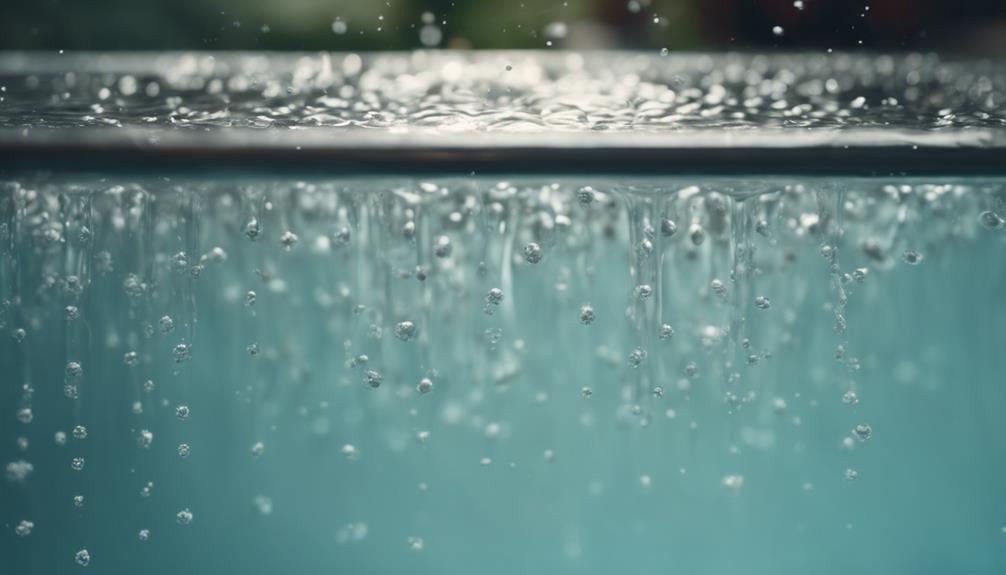
Flocculant works by causing small particles in your pool water to clump together, making them heavier and sink to the bottom of the pool. Here's how it achieves this:
- Clumping Together:
Flocculant initiates a process called coagulation, where it binds to smaller particles, facilitating the formation of larger and heavier clumps.
- Sink to the Bottom:
The heavier particles created by the clumping process gradually sink to the bottom of the pool, where they can be easily vacuumed or filtered out.
- Improve Water Clarity:
By removing suspended debris and contaminants, flocculant helps in enhancing the overall clarity of the pool water.
- Enhance Filtration Efficiency:
The removal of these particles not only improves water clarity but also boosts the efficiency of the pool's filtration system, reducing the need for excessive chemical treatments.
Understanding how flocculant works can help you effectively maintain your pool and ensure crystal clear water for an invigorating swim.
Proper Usage of Flocculant
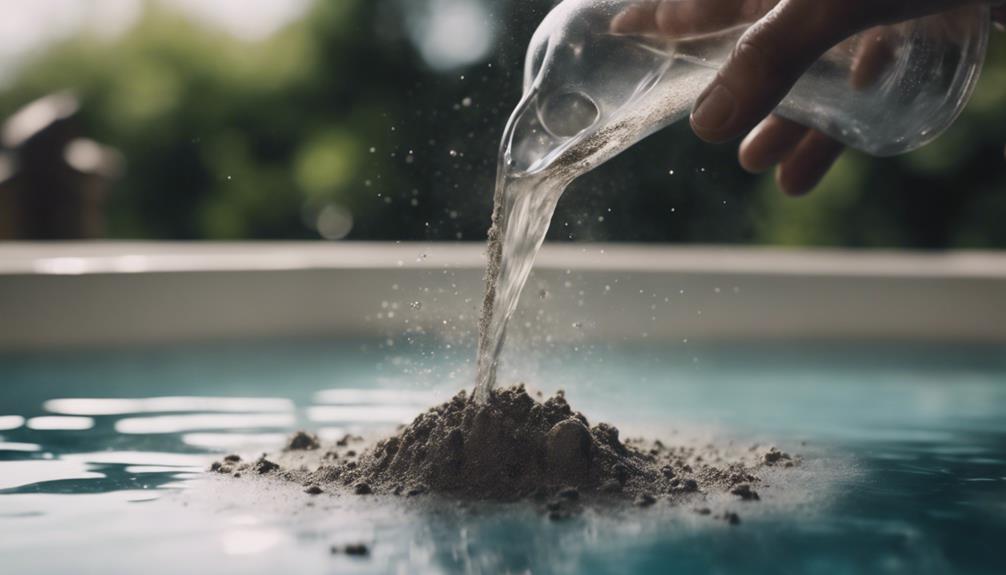
When using flocculant in your pool, it's important to add the correct amount according to your pool size and contamination levels.
Remember to pour the flocculant into the deepest part of the pool while the pump is running to guarantee even distribution.
Avoid the mistake of placing the flocculant directly into the skimmer basket or filter to prevent potential clogging issues.
Dos and Don'ts
Make sure to dilute the flocculant as per the manufacturer's instructions before adding it to your pool for best results.
When using flocculant in your pool, follow these dos and don'ts:
- Do test and balance the pool water pH levels before and after using flocculant for peak effectiveness.
- Avoid disturbing settled particles at the bottom of the pool while vacuuming to prevent clouding the water again.
- Run the pool pump for at least 2 hours after adding flocculant to ensure proper circulation.
- Avoid adding flocculant directly to the skimmer basket or filter; always add it to the deepest part of the pool with the pump running.
Application Tips
After understanding the dos and don'ts of using flocculant in your pool, guarantee proper application by diluting the product as instructed by the manufacturer for best results.
Essential dilution is vital to ensure the effectiveness of the flocculant. Add the flocculant slowly to the pool while the pump is running. This allows for even distribution of the product throughout the water.
Let the flocculant circulate in the pool for a minimum of 2 hours. This time allows the flocculant to clump together the particles in the water. Once the particles have settled to the bottom, vacuum the pool thoroughly. This step is crucial to achieve crystal clear water.
Remember to balance the pH levels of the pool both before and after using the flocculant. By following these application tips and manufacturer instructions precisely, you can enjoy a clean and clear pool for your relaxation and enjoyment.
Common Issues With Flocculant
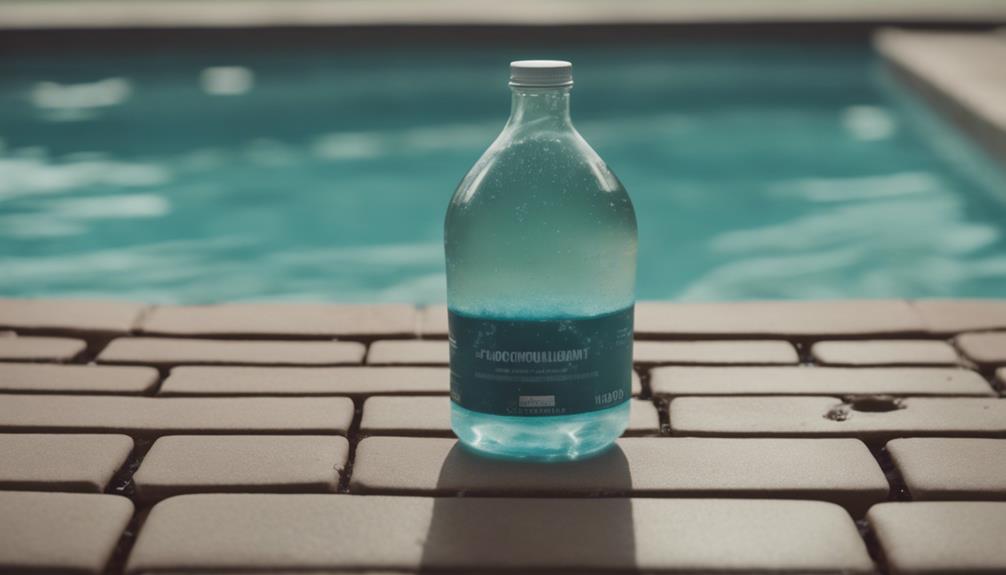
If you frequently notice cloudy water in your pool after using flocculant, you may be experiencing common issues with the treatment. Here are some common problems you might encounter:
- Incomplete Removal: Flocculant may not effectively remove all algae and debris, leading to persistent cloudiness.
- Unbalanced Chemistry: Incorrect chemical levels can interfere with the flocculant's performance, causing cloudy water.
- Improper Application: Using too much or too little flocculant can result in re-clouding or ineffective clumping of particles.
- Robotic Cleaners and Inadequate Vacuuming: Robotic cleaners may disturb settled particles, while insufficient vacuuming can leave lingering debris, both contributing to cloudy water.
If you face these issues, consider troubleshooting steps like retesting water chemistry, adjusting pH levels, and ensuring proper filtration and vacuuming techniques are applied. By addressing these common problems, you can enjoy a clear and inviting pool.
Removing Excess Flocculant

Experiencing an excess of flocculant in your pool can be remedied by effectively removing it using a pool vacuum on the Waste setting.
When vacuuming, focus on removing the particle clumps that have settled at the bottom of the pool. Slowly vacuum the pool to prevent stirring up settled debris, guaranteeing the efficient removal of excess flocculant.
After vacuuming, remember to top up the water level to maintain the proper balance. The particles, coagulated together by the flocculant in a process known as coagulation, can be efficiently eliminated by this method.
Dispose of the waste water following local regulations to avoid environmental harm. To monitor the water clarity post-flocculant removal, use a test kit to make sure the pool is balanced.
Keep an eye on the water clarity and balance, as well as regularly check the DE filters and the filter multiport to maintain excellent pool conditions.
Comparison: Flocculant Vs. Clarifier
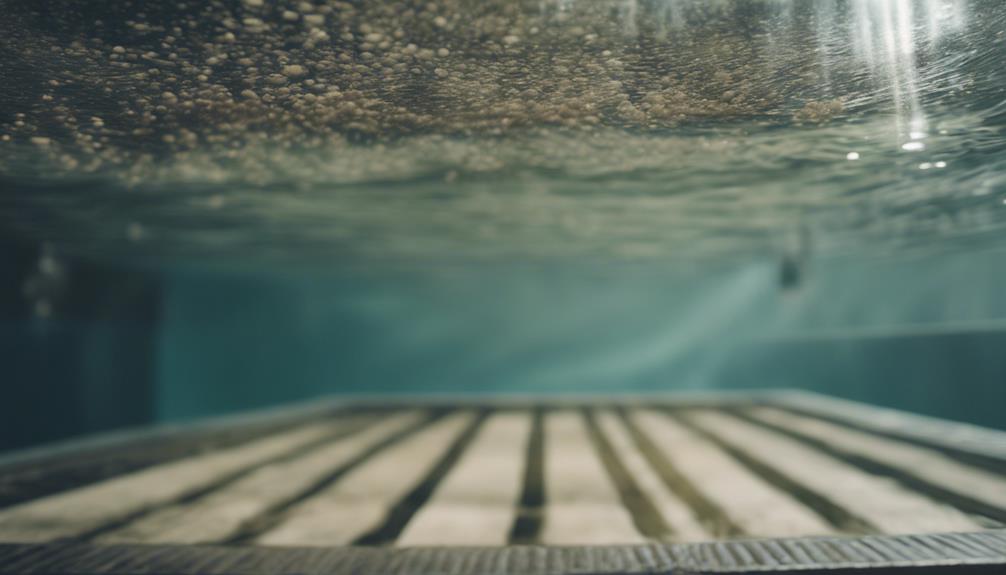
Comparing flocculant and clarifier reveals distinct differences in their mechanisms for improving water clarity in pools.
- Flocculant: This product works by clumping particles together, making them heavier to sink to the pool bottom. It requires vacuuming the settled particles for removal.
- Clarifier: Unlike flocculant, clarifier catches particles in the pool filter by coagulating them into larger masses that can be easily trapped.
- Filter Maintenance: When using flocculant, the pool filter is typically set to 'Recirculate' to avoid clogging, while clarifier aids in preparing particles for filter capture.
- Speed of Action: Flocculant acts faster than clarifier, usually within hours, providing quick and efficient results through the manual removal of clumped particles.
Understanding these distinctions can help you choose the right product based on your pool's needs, whether you prefer quick results with flocculant or a filter-dependent approach with clarifier.
Frequently Asked Questions
Can You Add Flocculant Directly to a Pool?
Yes, you can add flocculant directly to a pool, but it's important to do so correctly. Avoid pouring it into the skimmer basket or filter to prevent damage and clogging.
Instead, add flocculant to the deepest part of the pool with the pump running for even distribution. Following manufacturer instructions on how to add flocculant is essential for best results and to prevent filter issues.
Proper distribution helps the flocculant clump particles effectively for removal.
When Should I Use Flocculant in the Pool?
When dealing with extremely cloudy water caused by small particles in your pool, consider using flocculant. It's effective after heavy rain, algae blooms, or high debris levels from pool parties.
Flocculant isn't for regular maintenance but specifically targets water clarity issues when filtration alone isn't enough. It helps clear water effectively by clumping together tiny particles that are too small for the filter to catch.
Use it for quick results before special events or when needed.
Can You Run Flocculant Through Filter?
You shouldn't run flocculant through the filter in your pool. Doing so can lead to clogging and decrease the filter's efficiency.
For best results, add flocculant directly to the pool water and let it circulate before settling.
Always add flocculant to the deepest part of the pool with the pump set to 'Recirculate.'
The main purpose of flocculant is to clump small particles for easier removal, not to pass through the filter, avoiding potential damage.
How Much Floc Do I Need for a 10000 Gallon Pool?
For a 10000 gallon pool, you typically need around 8 ounces (1/2 pound) of flocculant. The amount required may vary based on the product's brand and concentration. It's important to adhere to the manufacturer's guidelines for accurate dosing.
Adjust the flocculant amount based on the water's cloudiness or particle level. After adding the flocculant, running the filter for 24 hours aids in efficient particle removal.
Conclusion
To guarantee, using flocculant in your pool can help clarify water by clumping together fine particles for easier removal.
One interesting statistic to take into account is that a properly maintained pool can save up to 50% on water and chemical costs compared to a neglected pool.
By understanding how flocculant works and when to use it, you can ensure your pool stays clean and clear all season long.
-
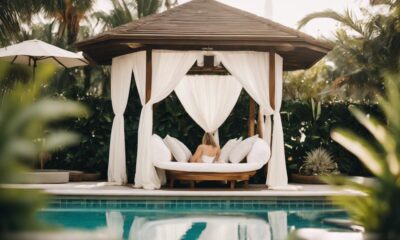
 Relaxation2 months ago
Relaxation2 months agoCreate a Relaxing Oasis: Top Poolside Lounging Ideas
-

 Vetted2 months ago
Vetted2 months ago15 Best Robot Vacuums for Pools to Keep Your Pool Sparkling Clean
-

 Health Benefits2 months ago
Health Benefits2 months agoDoes Swimming Pool Water Damage Teeth?
-
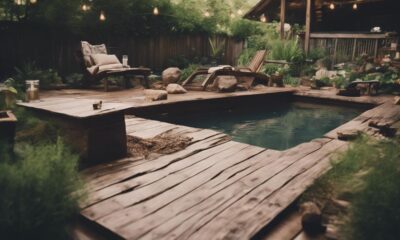
 Swimming Pools2 months ago
Swimming Pools2 months agoDo-It-Yourself: Inspiring DIY Swimming Pool Ideas
-

 Swimming Pools2 months ago
Swimming Pools2 months agoEntrepreneur's Guide: How to Start a Swimming Pool Business
-

 Pool Maintenance2 months ago
Pool Maintenance2 months agoMaster Chemical Balancing: Secrets to a Safe and Crystal-Clear Pool
-

 Swimming Pools2 months ago
Swimming Pools2 months agoDIY Fun: Homemade Swimming Pool Ideas
-
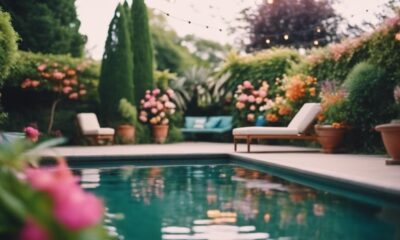
 Aesthetic and Design2 months ago
Aesthetic and Design2 months agoSmall Wonders: Small Garden Swimming Pool Ideas
















